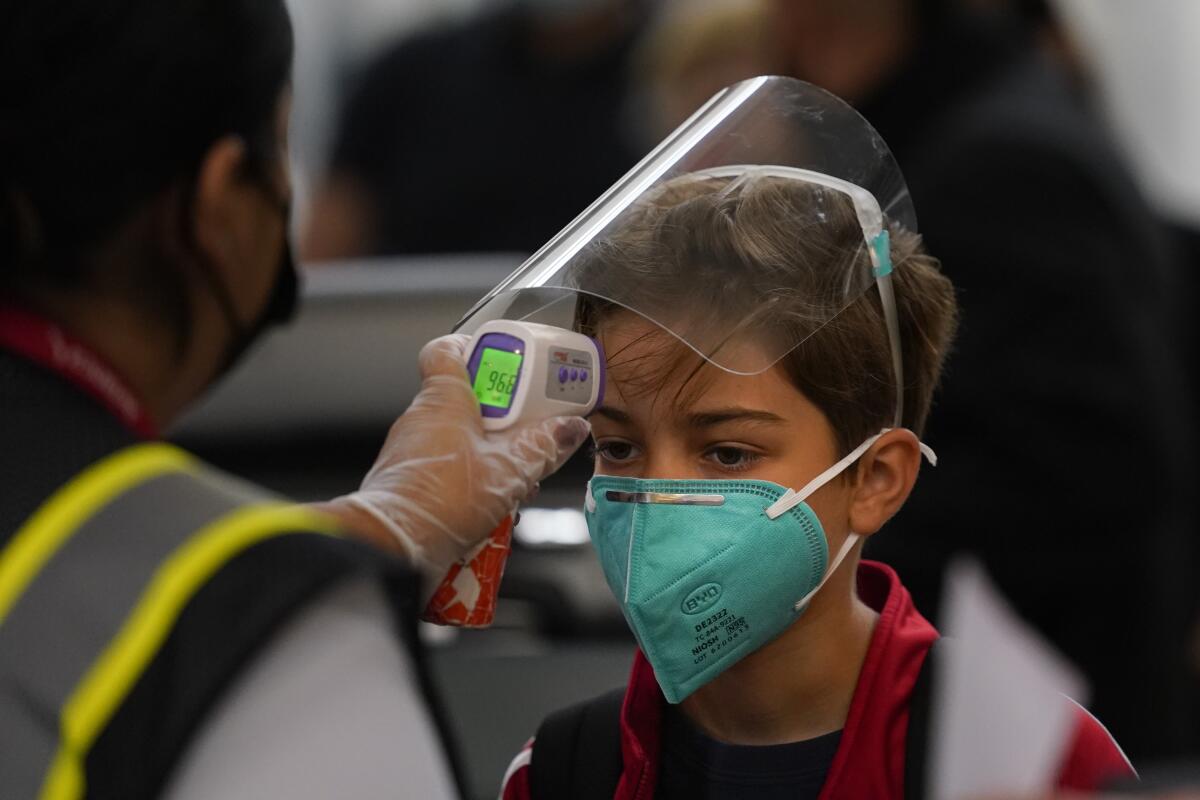‘Getting worse each day’: 1 in 145 L.A. County residents can infect others with the coronavirus

It could be your neighbors, or the man who brushed past you at the grocery store. Maybe it’s the last-minute addition to Thanksgiving dinner, or the friend who pulled their mask off next to you at the gym.
Throughout Los Angeles, COVID-19 is closer than ever.
One out of every 145 people in L.A. County is currently infectious with the disease, according to a model released by health officials Wednesday. This is a big jump from just two months ago, when the rate was estimated at 1 in 880 Angelenos.
Gov. Gavin Newsom has announced a stay-at-home order affecting most of California.
“Our situation is getting worse each day,” L.A. County Health Officer Dr. Muntu Davis said at a press briefing Wednesday where the numbers were unveiled.
The county has logged higher-than-ever cases of the coronavirus this week, but the latest calculation suggests the true number of people ill is even higher. The county uses a mathematical model to determine how many people — diagnosed or not — are actively contagious with COVID-19 and may spread it to others in the community, based on the number of people ending up in the hospital each day, officials say.
Relying on figures reported through Monday, the county’s data scientists found that approximately 0.69% of county residents, or roughly 69,000 people, can currently transmit the coronavirus to others. This does not include people who had the virus but are no longer infectious, nor those who were so recently infected that they are not yet contagious.
Across the country, epidemiologists calculate similar figures, though the formulas used to reach their estimates often differ. Still, the numbers provide a sense of how health officials are thinking about how widespread COVID-19 is in different parts of the country amid an overwhelming winter surge.
In Colorado, officials said this week that 1 in 41 people are currently infectious with COVID-19. Meanwhile, Chicago officials say that as many as 1 in 15 could be.
Nationwide, 3.6 million Americans were infectious with COVID-19 as of Sunday, which is about 1 in 100 people, according to a model created by Columbia University epidemiologist Jeffrey Shaman and his team. “The majority of these contagious individuals are unaware of their infections,” Shaman said in an email to The Times.
The estimates attempt to overcome one of the more insidious features of this coronavirus: as many as 40% of people infected have no symptoms. And for those who do develop a cough or fever, studies have found that they are most highly infectious to others before those signs appear, a major concern during the upcoming holiday season.
“We are programmed to feel safer around our family members or friends, so you’re more likely to let down your guard,” said Ali Mokdad, an epidemiologist at the University of Washington. “That’s why winter is going to be dangerous for us, because we want to convince the public who doesn’t have any symptoms to assume you are infected and you can be spreading the virus.”
When close to 1% of the population can be a vector, bending the curve down becomes more difficult. Once transmission begins to accelerate, more people in the community have the virus, so the same activities people have been doing for months become more dangerous. Those activities make more people sick, increasing the prevalence further, and the cycle continues.
“There’s just more COVID milling around our communities,” California’s top health official, Dr. Mark Ghaly, said Tuesday. “You are more likely to get infected with COVID just because it’s more available and more around our communities, even if you behave exactly like you did a month ago.”
Indeed, in L.A. County, health officials have said that the people falling sick with COVID-19 in the past few weeks have not made more trips to stores, restaurants, workplaces or anywhere else than those who fell sick a few months prior. A higher number of people are just falling sick at the same locations, they say.
“There’s risk involved even in these seemingly benign interactions,” Davis said Wednesday. “The numbers continue to be alarming.”
Davis also reported a rapid rise in cases and hospitalizations in recent days in the county. The acceleration has prompted the county to halt outdoor dining and instate a modified stay-at-home order this week. If case numbers do not abate, hospitals could be full in a few weeks and the death count could number in the thousands, officials say.
The county’s prevalence estimate is calculated by the Department of Health Services Modeling Team, which also predicts the demand for hospital beds and the county’s transmission rate, known as R. The prevalence figure was added in mid-June as a way to try to help people understand the far reach of the virus.
To calculate the percent infected, the model assumes that for every person sick enough to end up in the hospital with the disease, there are 39 others who are sick but did not go to a hospital, according to county officials.
Simply put, the number of people recently hospitalized with COVID is multiplied by 40. The data scientists then adjust that figure to exclude people currently hospitalized — since they are not infecting others in the community — and those who may have had COVID but are no longer infectious. The model assumes that each infected person is infectious for between 2 and 5 days.
Department of Health Services Director Dr. Christina Ghaly said that with so many ill who don’t know it, Thanksgiving could become a dangerous affair. She cited recent research finding that more than half of all infections come from people who did not have symptoms when they transmitted the virus to others.
“They might not know they’re infected … But they’re out there and they’re exposing other people to the virus,” she said. “That family meal is turned into an opportunity for COVID-19 to spread.”
One in 145 Angelenos being infected with COVID does not mean they will necessarily make others sick. Encounters with people who are contagious can be made safer by masks, social distancing and limiting the amount of time spent together, particularly in indoor environments, experts say.
Still, the prevalence of COVID-19 in the community is likely to only increase in the coming weeks as case numbers and hospitalizations continue to rise. The highest estimate ever documented in the county was in late June, when officials said that 1 in 140 were infected.
Those trends could be reversed with simple behavioral changes, but such improvement is not guaranteed, Christina Ghaly said.
“We don’t see that happening yet, so I do anticipate that the number will continue to rise,” she said.
More to Read
Sign up for Essential California
The most important California stories and recommendations in your inbox every morning.
You may occasionally receive promotional content from the Los Angeles Times.












